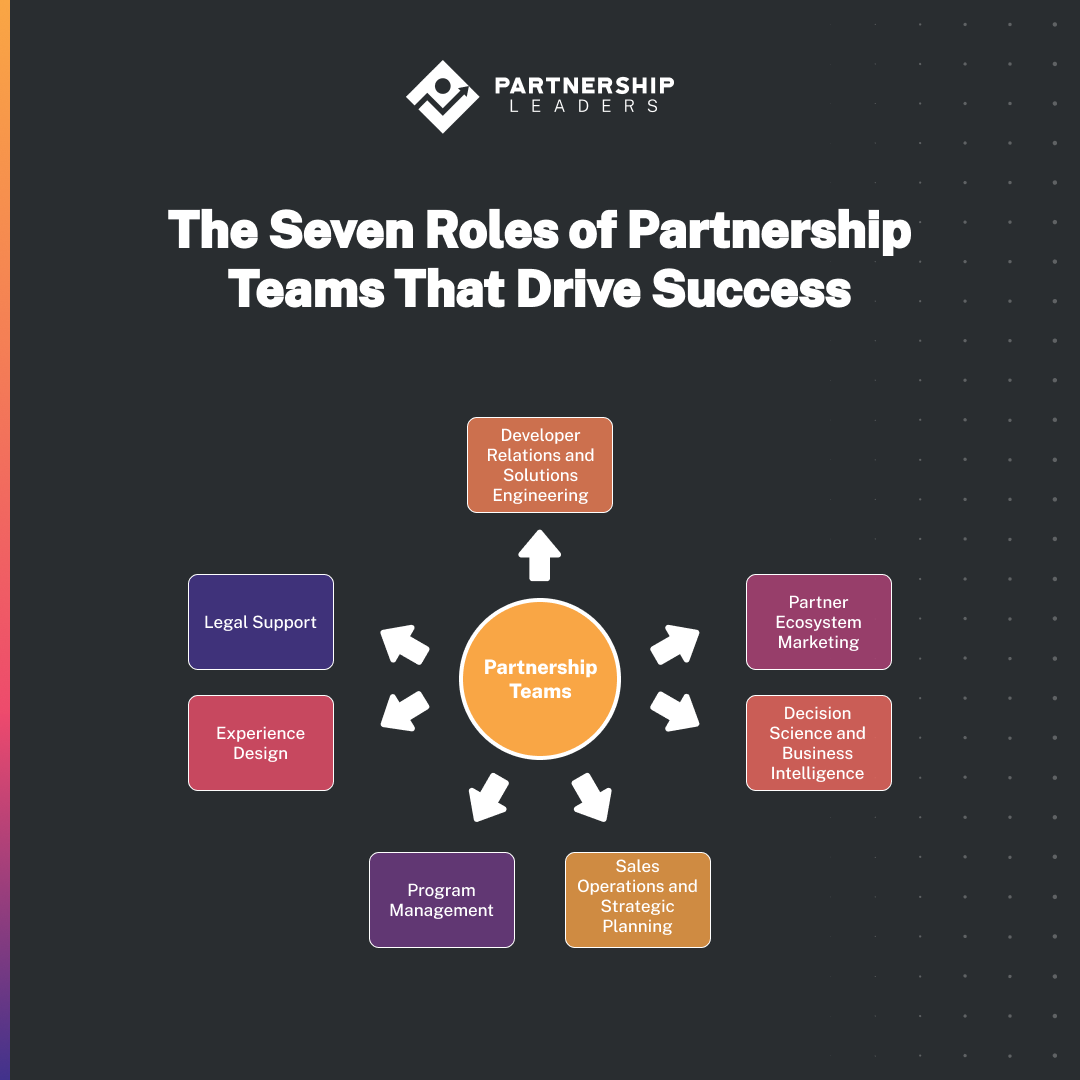Companies today often work in partnership with various types of companies at the same time. This demands partnership teams to be cross-functional and versatile to navigate different partnership dynamics efficiently.
Each type of partnership, whether it’s technical, marketing, or strategic, requires a unique approach. The diverse roles within partnership teams ensure that all bases are covered, making these collaborations successful and beneficial for all parties involved.
Here are seven roles that successful partnerships require and how you’ll succeed in each one:

1 – Developer Relations and Solutions Engineering
Developer Relations are the front-runners in establishing and maintaining a healthy technical rapport with partners. They translate technical jargon into plain language, making communication seamless.
On the other side, Solutions Engineers delve into the nitty-gritty of technical integrations, working closely with partners to tailor solutions that meet shared objectives.
Tips for Success
- Communicate Clearly: Whether it’s explaining complex technical ideas or understanding the partner’s technical requirements, clear communication is key.
- Stay Updated: Staying abreast of the latest technologies and industry best practices allows you to offer the best solutions.
- Be Solution-Oriented: Facing hurdles is a given. Adopting a solution-oriented mindset helps in overcoming challenges and driving the partnership forward.
This blend of technical expertise and interpersonal skills is crucial for companies looking to work in partnership with others, laying a robust foundation for joint ventures to thrive.
2- Partner Ecosystem Marketing
Engaging in partnerships often extends a company’s reach into new customer bases. The Partner Ecosystem Marketing role is about making these new connections known and fostering engagement between both partners’ audiences.
Tips for Success
- Know Your Audiences: Understand both your and your partner’s audience to create campaigns that resonate.
- Collaborate: Work closely with your partners in planning and executing marketing initiatives.
- Measure and Adjust: Keep an eye on the metrics to know what’s working and where adjustments are needed.
This role requires a good grasp of both partners’ market positions. It’s about identifying and leveraging mutual benefits in marketing efforts.
3 – Decision Science and Business Intelligence
Decision-making in partnerships often hinges on a solid understanding of data. The Decision Science and Business Intelligence role is pivotal in dissecting data to glean insights that drive smart, informed decisions.
Decision scientists delve into data to uncover trends and patterns, while business intelligence professionals translate these findings into actionable insights. This duo plays a critical role in evaluating the partnership’s performance and potential areas of growth.
Tips for Success
- Get Comfortable with Data: Embrace the numbers, metrics, and analytics tools that will become a part of your daily routine.
- Communicate Insights: It’s not just about finding the insights but effectively communicating them to stakeholders.
- Stay Curious: Keep probing, questioning, and exploring the data to uncover new opportunities and areas for improvement.
4 – Sales Operations and Strategic Planning
Sales form the lifeblood of many partnerships. The Sales Operations role is about ensuring that sales goals align with the partnership’s objectives, while Strategic Planning looks at the broader picture to ensure the partnership is on track for long-term success.
Sales Operations focuses on the practicalities of sales within the partnership framework, like targets, metrics, and sales enablement. Strategic Planning, on the other hand, is about aligning partnership goals with overall business objectives.
Tips for Success
- Align Goals: Ensure that both sales and partnership goals are in sync and support each other.
- Plan Ahead: Look beyond immediate sales targets to the long-term potential of the partnership.
- Use Data: Leverage data to inform sales strategies and to measure the effectiveness of strategic initiatives.
By harmonizing sales efforts with strategic partnership goals, companies can work in partnership more effectively, ensuring that both partners benefit from the collaboration.
5 – Program Management
Program Management is about steering the partnership’s projects and initiatives on a course that aligns with the agreed objectives. This role entails coordinating between various teams, managing resources, and ensuring that timelines are met.
A Program Manager acts as a linchpin, ensuring that all moving parts within the partnership are synchronized and moving towards the common goal.
Tips for Success
- Stay Organized: Keep a tight rein on timelines, resources, and communications.
- Facilitate Communication: Ensure open channels between all teams involved, fostering a collaborative environment.
- Evaluate Progress: Regularly review the progress of partnership initiatives against the set objectives and adjust plans as necessary.
Effective program management is crucial for maintaining the momentum and direction of partnership initiatives, ensuring they stay on track to deliver the desired outcomes.
6 – Experience Design
Experience Design in a partnership context is about creating a seamless and positive experience for both partners and end users. This role focuses on understanding and meeting the needs of all stakeholders involved.
It involves designing processes, interfaces, and interactions that make the partnership beneficial and enjoyable.
Tips for Success
- Understand Stakeholder Needs: Get to know the needs and expectations of both partners and their audiences.
- Iterate and Improve: Collect feedback and be ready to make adjustments to improve the partnership experience.
- Collaborate: Work closely with all teams to ensure a cohesive and positive experience.
7 – Legal Support
Legal Support is a fundamental part of forming and maintaining partnerships. This role involves ensuring that all legal aspects of the partnership are in order, from contracts to compliance with relevant laws and regulations.
Ensuring clear legal agreements and adhering to compliance standards safeguards the interests of all parties involved.
Tips for Success
- Clarify Agreements: Make sure all legal documents are clear, thorough, and understood by all parties.
- Stay Informed: Keep up with relevant laws, regulations, and industry standards to ensure compliance.
- Seek Expertise: Don’t hesitate to consult with legal experts to navigate complex legal matters.
Solid legal support not only protects the partnership but also provides a clear framework within which the partnership can operate successfully.
Conclusion
When teams work in partnership, they create a network of collaboration that can lead to better solutions, broader reach, and more opportunities. The work of partnership teams reflects how bringing different skills and perspectives together can lead to something greater than the sum of its parts. The sky’s the limit when it comes to how partnership teams can contribute to the success of collaborative ventures.
Join The 1850+ Leaders Transforming Partnerships
As a member of Partnership Leaders you will:
- Build and learn with the top partner people at the best companies around the world.
- Increase your impact and accelerate your career with proven resources, tools, and best practices.
- Grow a network of peers, partners, and advisors with common objectives.

